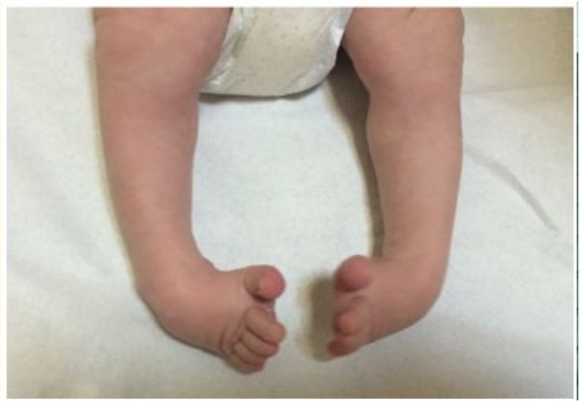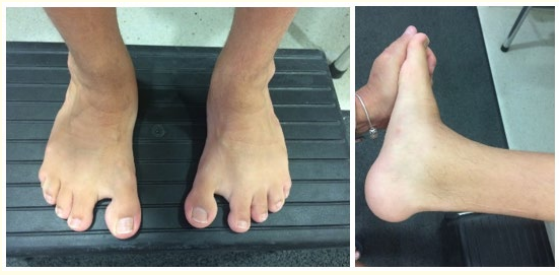Ey Batlle Ana Maria*, Marta Vinyals Rodriguez PhD, Paula Miguez Gonzalez MD PhD and David Moreno Romo MD
Equipo Ponseti Dra. Anna Ey, Clinica Diagonal (Barcelona), Spain
*Corresponding Author: Ey Batlle Ana Maria, Equipo Ponseti Dra. Anna Ey, Clinica Diagonal (Barcelona), Spain.
Received: August 09, 2024; Published: August 20, 2024
Citation: Ey Batlle Ana Maria., et al. “Evaluation of the Ponseti Method for the Treatment of Clubfoot Associated with Down Syndrome: A Case Series”. Acta Scientific Orthopaedics 7.9 (2024): 19-20.
This study aims to evaluate the outcomes of the Ponseti method in the treatment of clubfoot associated with Down syndrome. Traditionally, surgical intervention has been recommended for these cases; however, emerging evidence suggests that the Ponseti method may be effective without the need for surgery. This study evaluates the results of the Ponseti method in patients with clubfoot associated with Down syndrome and compares them with idiopathic cases.
Keywords: Clubfoot; Down Syndrome; Ponseti Method; Non-Surgical Treatment; Outcome
Clubfoot is a common congenital deformity, and its association with Down syndrome poses additional challenges in treatment. The Ponseti method, a non-surgical approach involving serial casting and Achilles tenotomy, has shown promising results in idiopathic clubfoot cases. However, its effectiveness in clubfoot associated with Down syndrome remains underexplored. This study aims to fill this gap by evaluating the outcomes of the Ponseti method in this specific and rare population.
A total of five patients with bilateral clubfoot associated with Down syndrome were included in this study. All patients were treated by the same senior orthopedic surgeon using the Ponseti method. The average age at the start of treatment was 9 months, ranging from 1 to 30 months. On average, three casts per foot were required, ranging from 2 to 6 casts. Achilles tenotomy was performed in six feet (60%), followed by a protocol of brace usage for all patients.
The results are collected in the following table

Table a
Ten clubfeet were identified in the five patients included in the study. All patients had bilateral clubfoot and were treated using the Ponseti method. The average age at the start of treatment was 9 months, ranging from 1 to 30 months. Two patients had received previous treatment, one conservatively and the other through posterior release. On average, three casts per foot were required, ranging from 2 to 6 casts. Achilles tenotomy was performed in six feet (60%), all of which achieved complete initial correction. Subsequently, all patients were included in a brace usage protocol

Figure a: Down Sd and clubfoot at birth.

Figure b: 13 years follow-up. After Ponseti Method Previous treatment: Posterior release.
Minimal complications were observed, with only one case presenting skin ulcers due to corticosteroid therapy for leukemia. Three out of five patients faced challenges with brace compliance, and unfortunately, one patient was lost to follow-up due to leukemia-related mortality. No joint or bony surgeries were required, and none of the eight feet evaluated during the last followup (6-14 years later) showed recurrence. Functionally, all eight feet were pain-free, functional without deformities, and exhibited flat feet with typical first toe adduction [1-3].
Contrary to previous recommendations favoring surgical intervention, this case series demonstrates that the Ponseti method can achieve excellent results in the treatment of clubfoot associated with Down syndrome without the need for surgery. The number of casts required and the frequency of tenotomy were comparable to those observed in idiopathic cases. Additionally, the incidence of recurrence was rare. These findings support the application of the Ponseti method in patients with clubfoot and Down syndrome, highlighting its efficacy and potential as a non-surgical treatment option. Further research and larger studies are needed to validate these findings and establish the long-term effectiveness of the Ponseti method in this specific population.
Copyright: © 2024 Ey Batlle Ana Maria., et al. This is an open-access article distributed under the terms of the Creative Commons Attribution License, which permits unrestricted use, distribution, and reproduction in any medium, provided the original author and source are credited.